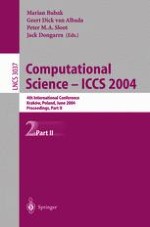The International Conference on Computational Science (ICCS 2004) held in Krak´ ow, Poland, June 6–9, 2004, was a follow-up to the highly successful ICCS 2003 held at two locations, in Melbourne, Australia and St. Petersburg, Russia; ICCS 2002 in Amsterdam, The Netherlands; and ICCS 2001 in San Francisco, USA. As computational science is still evolving in its quest for subjects of inves- gation and e?cient methods, ICCS 2004 was devised as a forum for scientists from mathematics and computer science, as the basic computing disciplines and application areas, interested in advanced computational methods for physics, chemistry, life sciences, engineering, arts and humanities, as well as computer system vendors and software developers. The main objective of this conference was to discuss problems and solutions in all areas, to identify new issues, to shape future directions of research, and to help users apply various advanced computational techniques. The event harvested recent developments in com- tationalgridsandnextgenerationcomputingsystems,tools,advancednumerical methods, data-driven systems, and novel application ?elds, such as complex - stems, ?nance, econo-physics and population evolution.
